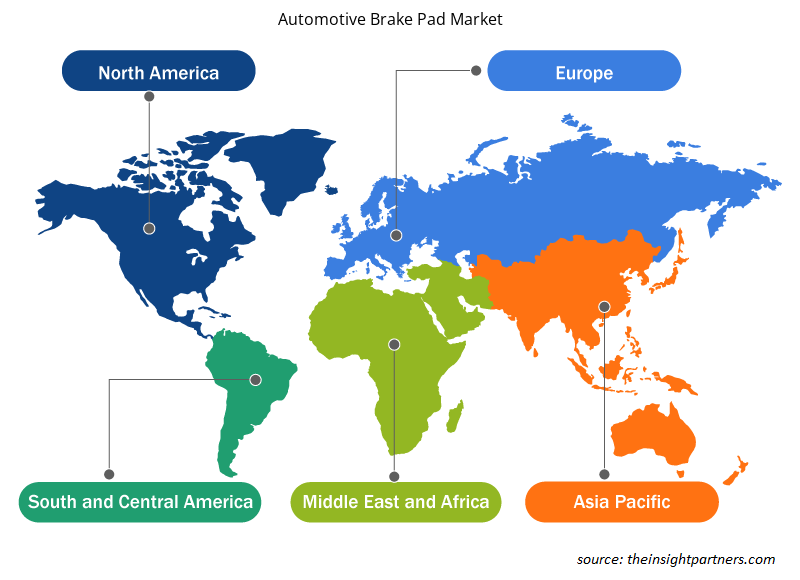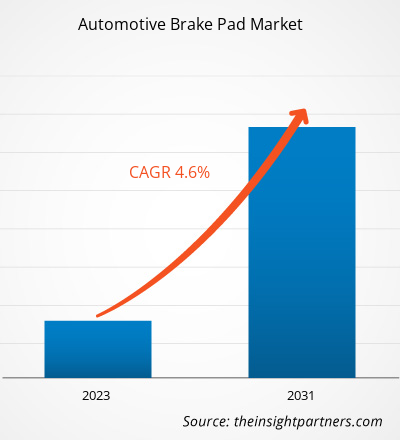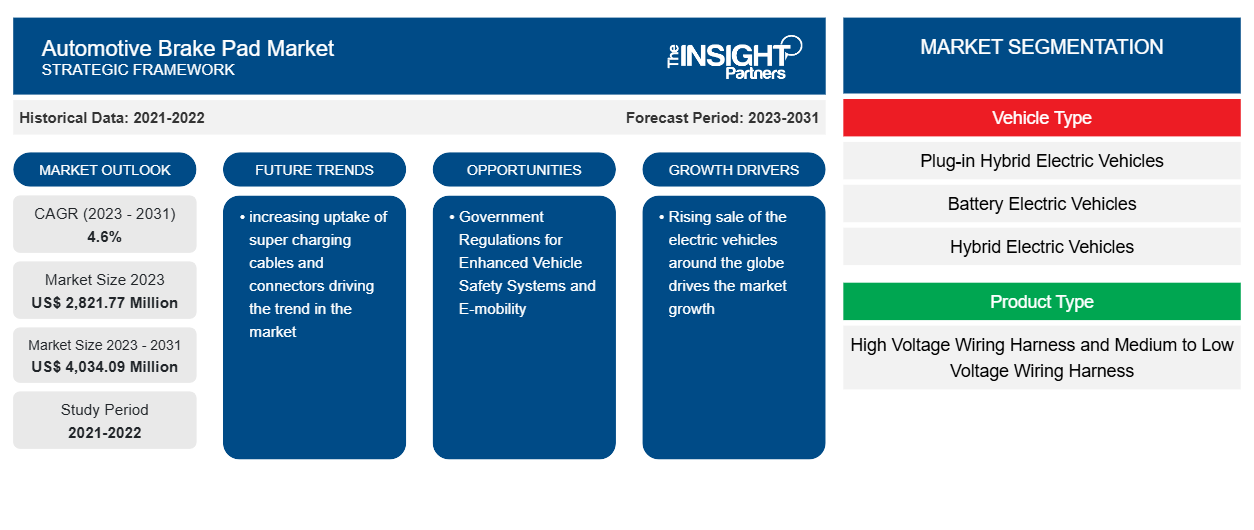자동차 브레이크 패드 시장 규모는 2023년 2,821.77백만 달러에서 2031년까지 4,034.09백만 달러에 도달할 것으로 예상됩니다. 이 시장은 2023-2031년 동안 4.6%의 CAGR을 기록할 것으로 예상됩니다. 상업용 및 승용차의 판매 및 생산 증가가 시장 추세를 주도하고 있습니다.
자동차 브레이크 패드 시장 분석
부스터와 전기-기계 시스템의 기술 발전, 고성능 차량의 사용 증가, 더 나은 안전을 제공하기 위한 디스크 브레이크에 대한 수요 증가는 자동차 디스크 브레이크 시장의 시장 성장을 주도하고 있습니다. 그러나 디스크 브레이크의 높은 제조 비용은 자동차 디스크 브레이크 시장의 성장을 제한할 수 있습니다. 또한 상용 차량에서 공기 디스크 브레이크의 사용이 증가하고 탄소 세라믹 브레이크 패드의 채택이 증가함에 따라 예측 기간 동안 자동차 디스크 브레이크에 대한 시장 기회가 창출될 것으로 예상됩니다.
자동차 브레이크 패드 시장 개요
글로벌 자동차 디스크 브레이크 시장 생태계의 주요 이해 관계자로는 하드웨어/구성 요소 공급업체, 자동차 디스크 브레이크 제조업체, 표준 및 규제 프레임 기관, 최종 사용자가 있습니다. 구성 요소/하드웨어 공급업체는 최종 제품을 제조하기 위해 디스크 브레이크 제조업체에 다양한 구성 요소/부품/원자재를 제공합니다. 브레이크 패드, 블리더 나사, 캘리퍼, 로터 및 하드웨어.
디스크 브레이크는 주철, 알루미늄, 스테인리스 스틸 등으로 만들어집니다. 글로벌 자동차 디스크 브레이크 시장의 주요 시장 참여자/제조업체로는 Thermo Fisher Scientific Inc., Brembo SPA, Continental AG, Knorr-Bremse Group, Robert Bosch GmbH 등이 있습니다. 브레이크 패드는 주로 승용차에 사용되지만, 브레이크 저항과 고속에서 안정적인 성능을 보이기 때문에 상용차 부문으로 확산되고 있습니다. 상용차에서는 드럼 브레이크가 디스크 브레이크로 대체되고 있는데, 이는 더 높은 품질과 더 긴 서비스 수명을 제공하기 때문입니다. Akebono와 같은 회사에서도 디스크 브레이크를 제공합니다.
귀하의 요구 사항에 맞게 이 보고서를 사용자 정의하세요
이 보고서의 일부 또는 국가 수준 분석, Excel 데이터 팩을 포함하여 모든 보고서에 대한 사용자 정의를 무료로 받을 수 있으며 신생 기업 및 대학을 위한 훌륭한 혜택과 할인 혜택을 이용할 수 있습니다.
-
이 보고서의 주요 시장 동향을 알아보세요.이 무료 샘플에는 시장 동향부터 추정 및 예측까지 다양한 데이터 분석이 포함됩니다.
자동차 브레이크 패드 시장 동인 및 기회
전 세계적으로 교통 체증이 급증하면서 도로 사고가 늘어나면서 시장 성장이 촉진됩니다.
자동차 디스크 브레이크와 관련된 성장과 기술 발전을 가능하게 하는 데 중요한 역할을 하는 시장에는 여러 다른 주변 이해 관계자가 관여합니다. 차량으로 인한 도로 사고가 증가함에 따라 안전 규정에 대한 필요성이 생겨 브레이크 시스템 규칙과 도로 안전에 대한 필요성이 커지고 있습니다. 세계보건기구에 따르면 매년 약 119만 명이 사망합니다. 자동차 브레이크 패드 시장의 주요 최종 사용자는 승용차와 상용차입니다. 또한 전 세계 도시 지역에서 교통 체증 문제가 증가함에 따라 예측 기간 동안 자동차 브레이크 패드 제품에 대한 수요가 증가하고 있습니다.
전기 자동차 판매 증가로 시장 성장에 충분한 기회 창출
전기 자동차는 차량의 제동 요구 사항을 충족하기 위해 브레이크 패드를 사용합니다. 브레이크 패드는 사고를 피하는 데 도움이 됩니다. 전기 자동차(EV) 산업의 성장이 증가함에 따라 제동 시스템 채택이 기하급수적으로 증가하고 있습니다. 환경에 미치는 유해한 배출물의 영향을 줄이기 위해 전 세계적으로 운영되는 정부 기관은 전기 자동차를 홍보하기 위해 필요한 조치를 취하고 있습니다. 예를 들어, 전기 자동차 이니셔티브는 전기 자동차의 도입과 채택을 촉진하는 다국적 정책 포럼입니다. 전기 자동차 사용이 증가함에 따라 고급 제동 시스템 사용 범위도 증가할 것입니다. 많은 전기 자동차가 재생 및 기계적 제동 시스템을 함께 사용합니다. 전기 자동차 브레이크 시스템에서 재생 및 기계적 제동 시스템은 에너지 절약에 도움이 됩니다.
자동차 브레이크 패드 시장 보고서 세분화 분석
자동차 브레이크 패드 시장 분석에 기여한 주요 세그먼트는 재료 유형, 차량 유형 및 지역입니다.
- 재료 유형에 따라 시장은 금속 브레이크 패드, 반금속 브레이크 패드, 세라믹 브레이크 패드, 석면 브레이크 패드, 비석면 유기 브레이크 패드로 구분됩니다. 이 중에서 금속 브레이크 패드는 2023년에 가장 큰 점유율을 차지했는데, 이는 전 세계 승용차 수요 증가 때문입니다.
- 차량 유형에 따라 시장은 상용차와 승용차로 나뉩니다. 이 중 승용차 부문은 2023년에 더 큰 점유율을 차지할 것이며, 이는 전 세계 승용차의 sae 덕분입니다. 국제 자동차 제조업체 기구에 따르면, 전 세계 승용차 판매량은 2023년에 6,520만 대에 도달하여 전 세계 5,860만 대에서 증가했습니다.
지역별 자동차 브레이크 패드 시장 점유율 분석
자동차 브레이크 패드 시장 보고서의 지리적 범위는 주로 북미, 아시아 태평양, 유럽, 중동 및 아프리카, 남미 및 중부 아메리카의 5개 지역으로 나뉩니다.
APAC는 가장 빠르게 성장하는 경제 지역으로 간주되며, 중국과 인도는 세계에서 1위와 3위로 가장 빠르게 성장하는 경제입니다. 일본은 이 지역에서 가장 기술적으로 진보된 국가로 자동차 타이어 시장 개발에 기회를 제공합니다. 베트남, 말레이시아, 인도네시아와 같은 동남아시아의 신흥 경제권은 승용차 판매가 증가하고 있으므로 자동차 브레이크 패드에 대한 수요가 증가할 것으로 예상됩니다.
북미는 미국과 캐나다 전역에서 자동차 판매가 증가함에 따라 빠른 속도로 성장하고 있습니다. 북미 자유 무역 협정(NAFTA)은 미국, 캐나다, 멕시코 간에 체결된 협정입니다. 이는 3개국 간의 자유 무역 및 투자에 대한 대부분의 관세 및 비관세 장벽을 낮추었습니다. 이는 북미 국가의 무역 및 투자 수준을 높이는 데 더욱 도움이 되었습니다. 또한 멕시코는 자동차 제조 NAFTA의 강자로 부상하고 있으며, 지난 몇 년 동안 매달 43억 달러 이상의 부품과 26억 달러 상당의 완제품을 미국에 공급하고 있습니다.
자동차 브레이크 패드 시장 지역 통찰력
Insight Partners의 분석가들은 예측 기간 동안 자동차 브레이크 패드 시장에 영향을 미치는 지역적 추세와 요인을 철저히 설명했습니다. 이 섹션에서는 북미, 유럽, 아시아 태평양, 중동 및 아프리카, 남미 및 중미의 자동차 브레이크 패드 시장 세그먼트와 지리에 대해서도 설명합니다.

- 자동차 브레이크 패드 시장에 대한 지역별 특정 데이터 얻기
자동차 브레이크 패드 시장 보고서 범위
| 보고서 속성 | 세부 |
|---|---|
| 2023년 시장 규모 | 2,821.77백만 달러 |
| 2031년까지 시장 규모 | 4,034.09백만 달러 |
| 글로벌 CAGR (2023-2031) | 4.6% |
| 역사적 데이터 | 2021-2022 |
| 예측 기간 | 2023-2031 |
| 다루는 세그먼트 |
차량 유형별
|
| 포함된 지역 및 국가 |
북아메리카
|
| 시장 선도 기업 및 주요 회사 프로필 |
|
시장 참여자 밀도: 비즈니스 역학에 미치는 영향 이해
자동차 브레이크 패드 시장은 소비자 선호도의 변화, 기술 발전, 제품의 이점에 대한 인식 증가와 같은 요인으로 인해 최종 사용자 수요가 증가함에 따라 빠르게 성장하고 있습니다. 수요가 증가함에 따라 기업은 제품을 확장하고, 소비자의 요구를 충족하기 위해 혁신하고, 새로운 트렌드를 활용하여 시장 성장을 더욱 촉진하고 있습니다.
시장 참여자 밀도는 특정 시장이나 산업 내에서 운영되는 회사나 기업의 분포를 말합니다. 주어진 시장 공간에 얼마나 많은 경쟁자(시장 참여자)가 존재하는지 그 규모나 전체 시장 가치에 비해 나타냅니다.
자동차 브레이크 패드 시장에서 운영되는 주요 회사는 다음과 같습니다.
- Coroplast Fritz Müller Gmbh & Co. Kg
- 후지쿠라 주식회사
- 후루카와 전기 주식회사
- 마더슨 수미 시스템 유한회사
- 넥산스 오토일렉트릭 GmBh
- 신본전자(주)
면책 조항 : 위에 나열된 회사는 어떤 특별한 순서에 따라 순위가 매겨지지 않았습니다.

- 자동차 브레이크 패드 시장 주요 주요 업체 개요를 알아보세요
자동차 브레이크 패드 시장 뉴스 및 최근 개발
자동차 브레이크 패드 시장은 1차 및 2차 조사 후 정성적, 정량적 데이터를 수집하여 평가합니다. 여기에는 중요한 기업 간행물, 협회 데이터 및 데이터베이스가 포함됩니다. 자동차 브레이크 패드 시장의 몇 가지 개발 사항은 다음과 같습니다.
- 델파이는 BEV 애플리케이션의 특정 요구 사항에 맞춰 새로운 BEV 브레이크 패드 제품군을 출시한다고 발표했습니다. 자세한 비교에 따르면, 이 제품군은 오늘날 독립 애프터마켓에서 가장 인기 있는 모델을 포괄하는 세계에서 가장 포괄적인 제품군 중 하나입니다. 차량에는 BMW i4/iX, Mercedes EQC/EQEE/QS, Porsche Taycan/Cross Turismo와 같은 최신 모델 외에도 Nissan Leaf와 Tesla Model S/Model 3이 포함됩니다. 유럽에서 운행 중인 270만 대의 차량을 포괄하는 52개 부품 번호를 도입한 델파이는 워크숍에 대한 상당한 서비스 기회를 제공하고 있습니다. (출처: 회사 웹사이트, 2024년 2월)
- Allied Nippon은 전기 자동차를 위한 완전히 새로운 모든 기능을 갖춘 브레이크 패드 제품군인 EV+를 출시했습니다. (출처: 보도자료, 2023년 6월)
자동차 브레이크 패드 시장 보고서 범위 및 제공물
"자동차 브레이크 패드 시장 규모 및 예측(2021-2031)" 보고서는 아래 영역을 포괄하는 시장에 대한 자세한 분석을 제공합니다.
- 범위에 포함된 모든 주요 시장 세그먼트에 대한 글로벌, 지역 및 국가 수준의 자동차 브레이크 패드 시장 규모 및 예측
- 자동차 브레이크 패드 시장 동향 및 운전자, 제지장치 및 주요 기회와 같은 시장 역학
- 자세한 PEST 및 SWOT 분석
- 주요 시장 동향, 글로벌 및 지역 프레임워크, 주요 업체, 규정 및 최근 시장 개발 사항을 포괄하는 자동차 브레이크 패드 시장 분석
- 시장 집중도, 히트맵 분석, 유명 업체 및 자동차 브레이크 패드 시장의 최근 개발 사항을 포함하는 산업 환경 및 경쟁 분석
- 자세한 회사 프로필
- 과거 분석(2년), 기준 연도, CAGR을 포함한 예측(7년)
- PEST 및 SWOT 분석
- 시장 규모 가치/거래량 - 글로벌, 지역, 국가
- 산업 및 경쟁 환경
- Excel 데이터세트
최근 보고서
사용 후기
구매 이유
- 정보에 기반한 의사 결정
- 시장 역학 이해
- 경쟁 분석
- 고객 인사이트
- 시장 예측
- 위험 완화
- 전략 기획
- 투자 타당성 분석
- 신흥 시장 파악
- 마케팅 전략 강화
- 운영 효율성 향상
- 규제 동향에 발맞춰 대응























 무료 샘플 받기 - 자동차 브레이크 패드 시장
무료 샘플 받기 - 자동차 브레이크 패드 시장